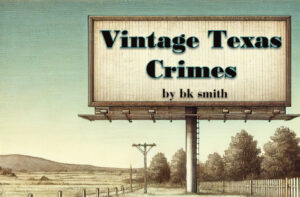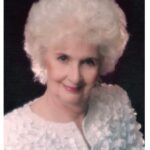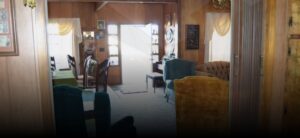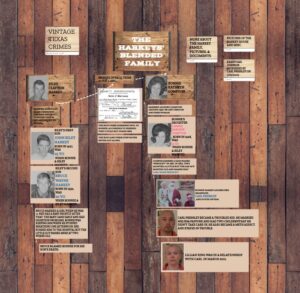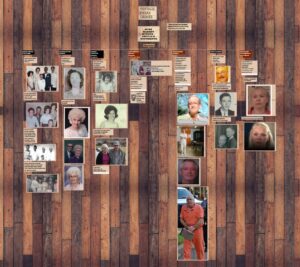This video is an overview of the story that I’ve written below.
This is a story about family, one of the OLD Texas families, the Harkeys, 6th generation Texans, who had worked hard and accumulated wealth in land and a pecan business. When a grandmother didn’t die quick enough, she and her caretaker were murdered.
In today’s story, I leaned heavily on Texas Monthly’s 2014 article about this crime, the Dateline episode that aired in 2015, and several media releases. I will include my sources below. Now, let’s get to it!
March 25, 2012—The Crime
Today, we are going to San Saba, Texas, the Pecan Capital of the World. The little town lies 105 miles northwest of Austin, the closest large city to it, and San Saba is 141 miles north of San Antonio.
It was Sunday after church; probably about noon when Isaiah Johnson, a boy of 12 years old, his mother, Karen Gail Johnson, and 84-year-old Mrs. Bonnie Harkey returned from attending the early service at San Saba’s First Baptist Church that morning.
- Karen Gail Johnson, Caretaker
- Bonnie Harkey
Isaiah headed off to a spare bedroom, upstairs and far away from the front room where his mother and Bonnie were. There, Isaiah could watch television and play video games, and no one would be disturbed by the noise. Isaiah’s mother, Karen, was Mrs. Harkey’s caretaker, so you might say Karen and Isaiah spent a lot of time there, or maybe even lived there. Mrs. Harkey was frail, and she had to have 24-hour care.
Karen went about her usual routine, and Bonnie Harkey changed into a teal jogging suit before she settled into her maroon recliner with her beloved black and white cat, Miss Kitty, in the paneled front room of the Harkey home. She had a church-related magazine within reach of her.
About 5:30 that afternoon, the setting sun cast shadows from the trees across the windows where Isaiah was playing. Boys can fall into a game trance and lose all track of time, and that must be why Isaiah didn’t realize he had been upstairs for four or five hours. He had been playing video games for a long time. Isaiah opened the door, and the house was weirdly quiet. Isaiah left the room where he had been occupied all afternoon and went downstairs, looking for his mother. Mrs. Harkey wasn’t in her chair in the front room and Miss Kitty wasn’t in sight. Isaiah called out, “Mom?” No one answered.
He crossed through the empty front room, and that’s when he found his mother lying on the floor in the entryway. I don’t know if he shook her or just called her name, but he knew his mother was dead almost instantly. Isaiah knew that “Bonnie,” as he called her, might be asleep in her bedroom, so he rushed in there. The pink and white bedroom was empty. He checked the other rooms on the first floor of the house, calling out her name. The white-haired woman did not answer.
Isaiah grabbed the cordless telephone beside Mrs. Harkey’s empty chair and stepped around his mother’s body to go outside on the porch and call 911. Terrified, but maintaining his composure better than most adults could, Isaiah told the 911 operator that his mother was dead and Bonnie was missing. The dispatcher asked him for the address to the house where he was, but Isaiah didn’t know the address, but it was of no consequence, because everyone with a little age on them knew where the Harkeys lived.
Isaiah remained standing on the front porch of the red brick house, and the tears came. He and his mother were alone in San Saba; the rest of his mother’s family was in Virginia. He couldn’t hold back the tears, but when the sheriff arrived first, he did his best not to cry and to answer all of Sheriff Allen Brown’s questions.
Right behind the sheriff came deputies and first responders down the country road and pulled up in front of the well-known Harkey house. A shaken, but poised, Isaiah told them how he had been playing video games in another room with the door closed since about 1:00, and he hadn’t been alerted by a commotion.
The sheriff and his deputies knew that in the rambling, two-story red brick house, it would be easy to be in one part of the house and not know what was going on in another part. The house was just under 5,000 ft. sq., and the back sunporch alone could seat 28 people comfortably for a meal.
Inside the house, the walls in most rooms were covered with family photos; collections of nicknacks sat in clusters just about everywhere you looked.

One of Bonnie’s Paintings
Many of Bonnie Harkey’s own paintings covered the walls, and in the utility room hung many blue ribbons and red ribbons for her prizewinning pies that she had entered in the county fair competitions; next to them, awards for growing top notch pecans garnered by her late husband, Riley Harkey, hung resolutely in their places. Bonnie also had a couple of awards of her own for her efforts at keeping the orchard running and producing top quality pecans after Riley passed away.
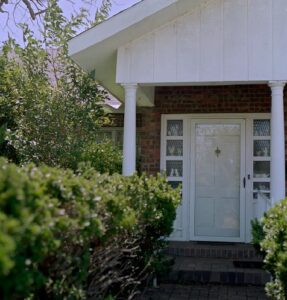
Harkey Home
The house was 85 years old, and before Bonnie had become weakened by age and the onset of dementia, she had entertained guests there regularly. The house, built by Riley’s parents when he was a baby, had been known far and wide in San Saba County during Bonnie’s younger years, especially before Riley passed. It had been a place to have get-togethers of all kinds, cookouts, holiday parties, church socials, and club meetings, and every event came with a delicious meal or snacks served from Bonnie’s kitchen and topped off with one of her special pecan deserts.
Bonnie liked to socialize; she loved joining clubs, going to church, and entertaining guests in her home—people in San Saba were quite fond of Bonnie.

One of the Harkey Orchards
The house sat on the edge of 300 acres of pecan orchards. It was situated way back on a private country road made from packed caliche. The road made a turn off Texas Highway 190 and ran straight back about a quarter of a mile into a line of trees. You can’t even see the house from Highway 190, just pasture, and the tree line—presumably pecan trees.
As you have already figured out, growing pecans was this family’s lucrative business.
Mrs. Harkey possessed standing in the community because she married into a family with a long history in San Saba, and of course, because of the family’s vast, high-producing pecan orchards, her love of people, and because she was perceived as wealthy. Everyone knew the “Pecan Queen” of the Harkey family and San Saba.
After the 911 call, police initially thought Bonnie could have wandered off in confusion when she saw Karen was non-responsive. Or was something more going on here?

Bonnie Harkey in her 80s
The white-haired matriarch had lived in her home since the 1960s and she wanted to stay there until she died. Bonnie Harkey didn’t want to go to a nursing home, so her guardian, her friend Betty Ann, found Karen to look after her. She took excellent care of Mrs. Harkey who, besides having dementia, had an abdominal aortic aneurism that could kill her at any time.
It worked out perfectly that 51-year-old Karen Johnson took care of her.
Karen had red hair and a kind heart. During Karen’s funeral, it was said that Isaiah was the “love of her life” and that she adored her son. She was a hardworking lady who had been in the area for a few years, somehow finding her way to Central Texas all the way from Virginia, and once here, she curved out her niche as a caretaker to folks needing her in San Saba.
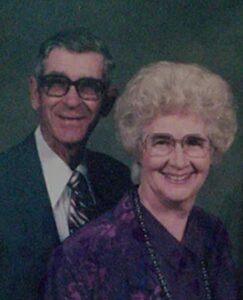
Riley and Bonnie Harkey in the 1990s
The first lawman on the scene, Sheriff Allen Brown, a longtime resident of San Saba, thought highly of Bonnie Harkey and her late husband. He thought it possible that Karen had a heart attack or a stroke. She had been sprawled facedown just inside the front door. The only sign of a struggle was a broken fingernail. Because she was 51, the sheriff believed it possible that she died of natural causes.
As more members of law enforcement arrived, search parties formed and began combing the 300 acres surrounding the house. Teams comprised of volunteers on ATVs, local firefighters, sheriff’s deputies, and a bloodhound named J.J. from the nearby state prison were on the move. They fanned out across the property as a DPS helicopter dispatched from Waco made slow circles overhead, scanning the ground with heat-imaging cameras.
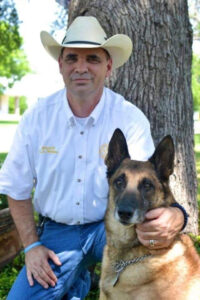
Allen Brown, Sheriff in 2012
The volunteers looked for hours. When J.J. tracked Bonnie from the house to the driveway and lost her scent, it was obvious that she had left the property in a car, which left Sheriff Brown puzzled. And then, a call came in that pivoted the search into an investigation.
The Family History
We need to sort out the Harkey Family History before we move forward, but only going back to 1963 when Bonnie and Riley met. Now, if you are the kind who loves Texas history like I do, track down the Texas Monthly article. The Harkey family goes back about six generations in pecan tree history to two brothers, Riley and Israel Harkey. They founded a little town right by San Saba which they named “Harkeyville.”
But as interesting as that part is, I don’t want to make this long story any longer!
+++
Both Bonnie and her husband, Riley, had been divorced when they met. Riley was married first to a woman named Joan Banta Harkey.
Riley was dedicated to farming the pecan orchard and that life wasn’t enough for Joan—and I’m not blaming her. She stayed with it for 17 years and I’m guessing maybe Riley wasn’t the ideal husband.
In 1962, Joan said, “Good-bye,” and headed to Sparks, Nevada, leaving her boys with Riley. He wanted a wife to do all those things that wives did in 1963. Riley was a tall man with the build of a wiry farmer who gets out and abuses his body every day, making things thrive. When he was introduced to a tall, pretty woman from Waco named Bonnie Compton, an operator for the telephone company, he knew he had found the woman who could make his life complete.
She had a 14-year-old daughter named Connie and knew how to mother; she was smart and hardworking. Bonnie was divorced from Connie’s father, a traveling salesman who left her for another woman, according to Bonnie. She liked what Riley had to offer: his work ethic, stability, security, standing in the community, and a future. Through Riley, she got her confidence back, and she could again be a homemaker and fit the mold of what women were expected to do in the 1960s. As soon as they married, Bonnie quit her job and became a full-time wife and homemaker.
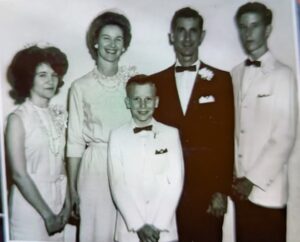
The Harkeys Wedding Day in 1963
They made a handsome couple, both tall, with dark hair and blue eyes. However, for Bonnie, their marriage wasn’t perfect, but she stayed with Riley and made the best of it until Riley’s death in 1995.
Riley must have indulged her wants and whims to a degree, because Bonnie added a room onto the back of the house, “the sunporch” where she served large family meals on holidays, and she had people over all the time, something that wasn’t the norm for Riley. She also convinced Riley, who attended the Church of Christ, to join the Baptist Church, where she was a member. They had great couple friends in the Baptist church with whom they took little trips and big trips, and enjoyed being with. Also, Bonnie added a bedroom and turned a closet into a bathroom in their house.
She busied herself with joining clubs and getting to know people around San Saba. People who have moved into small towns in Central Texas know the people are often standoffish from outsiders. It is difficult to become “one of them” when “you aren’t from here.” But that wasn’t the case with the people of San Saba. Bonnie was soon beloved in the town.
Riley’s boys, John and Bruce, ages 15 and 10, respectively, were a challenge to Bonnie, and according to friends and Bonnie’s niece, who appeared on Dateline, Rylie didn’t make them behave respectfully at all to Bonnie. They would do things like take a bite of the food she cooked and spit it out on their plates, saying it was awful. Riley didn’t even try to stop that kind of thing. But according to another opinion I read on social media, Riley tried to get it under control.
Bonnie tried to provide structure, tried to have rules for house behavior, and encourage manners and chores, but it didn’t work.

1964 Pink Thunderbird Coupe like the one Riley bought Bonnie when they married.
Bruce Harkey was a handful, and they butted heads. He never liked Bonnie and claimed she was mean to him from the moment she married his father. He said in one interview she was driving a new “desert rose Thunderbird” right after the couple married, inferring that she was already getting money from his father. However, Bonnie and Riley made it work. Sometimes, even Riley produced his share of rudeness, interrupting and correcting her right in the middle of telling a story to someone else, “No, Bonnie. You aren’t telling it right.”
Friends also said they would fight it out right in front of other people, making everyone a little uncomfortable.
The kids finally grew up.
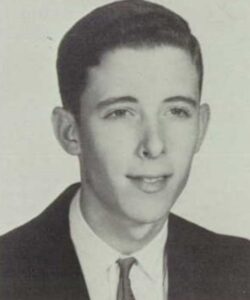
John Harkey 1965 Senior Picture
First, John left home in 1965 to go to Texas Tech University in Lubbock. He graduated and became a hard-working businessman in the Dallas-Ft. Worth area; later, he was a happy family man.
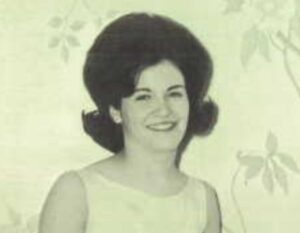
Connie as 1967 Homecoming Queen
Connie left home and also attended Texas Tech in 1967, and during this time, Bruce was a teen and bounced around between Texas and Nevada. Part of the time he lived in Nevada with his mother and when he was in San Saba, he chose to live with his grandparents in town rather than live with Riley and Bonnie. (Side note: Riley’s parents bought a house in town when Riley was in his 30s, and his father was ready to stop farming. They handed the orchards and house over to him because he had been working in the orchards all his adult life.)
Bruce married wife #1, Judy, and on April 1,1970, he became a father at age 17, to baby boy Eric, but Eric only lived to be two weeks old. The baby seemed healthy, but they learned his epiglottis was not fully developed, meaning that after feedings, Eric had to be held or laid on his stomach so that he wouldn’t choke on spit-up. Bonnie had them move to the house with her and Riley so she could help with the baby. One day, Eric stopped breathing during his nap and Bonnie took him to the hospital, to no avail. Bonnie was devastated, and Bruce never forgave her for his son’s death and believed she caused it on purpose.
After Eric’s death, Judy and Bruce divorced, and Bruce went to Texas Tech, but he didn’t finish. (Here is a link to a supplemental blog post that will give you a lot more detail about Bruce Harkey.)
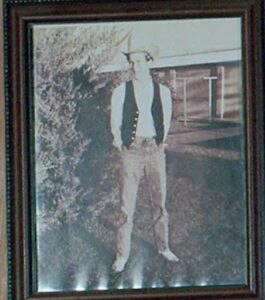
Bruce as a teen.
In 1980, Connie married to Clarence Edward Pressley. She and her husband adopted an eight-month-old boy in 1984; they named him Carl Wade Pressley, and his adoptive grandmother, Bonnie, doted on him from the beginning. Supposedly, the little boy was living in a car with his parents. The family was homeless and readily agreed to let Connie adopt the little boy.
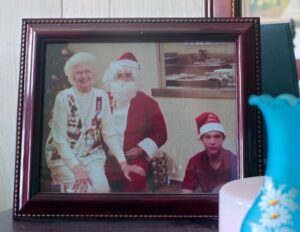
Bonnie, Santa, and Carl
Today, we know that mothers who take drugs or drink while pregnant can cause immense problems in babies; and if the parents were addicts, Carl probably never bonded properly to his parents, which basically sets a person up to have little to no moral compass, maybe to even have anti-social personality disorder.
Carl had a serious problem with ADHD as a child; and he began to get in trouble during his teen years. According to my sources, it was because of his love of meth and motorcycles. He did so much meth that his bottom teeth had become little yellow pegs in his mouth. At some point, probably after he tried to run over his stepfather with a tractor, Connie apparently said “enough,” and Bonnie let him move in with her; for a while, Bonnie indulged his every whim. Riley was dead, and she was probably lonely. If Carl wanted a new truck, he got one. If he wanted a motorcycle, he got one. If Carl wanted a herd of expensive goats to raise, which he did, and he got that. Bonnie indulged him about almost everything for a long time.

Carl in his 20s
In 2003, at age 19, Carl married a girl named Melissa, and he had two children with her, but he wasn’t much of a husband or a father. He used meth regularly, and they separated. Between 2003 and 2008, Carl was convicted of driving while license invalid four times. Plus, he was convicted of assaulting his first wife (he choked her), and he is convicted of harassment and violation of a protective order.
He had started dating a girl named Lillian King sometime prior to 2008 because Carl and Lillian had a little girl together who was born that year.
Carl Pressley had turned into a small town thug prone to temper tantrums. He was not allowed to come on the property of the Baptist church where Bonnie attended because he came there once and verbally attacked her, demanding that she give him money. Another time, he went there and insisted that she purchase him a new set of tires and blocked her car so that she could not leave. The family and her church friends told her to stop giving Carl money, but Bonnie said it wasn’t Christian.
The episode of Dateline that aired on April 23, 2015 about the Harkeys said that Carl stole truckloads of pecans from Bonnie during harvest time anytime he could. Sometimes, he brought in nearly $1,000 worth of pecans belonging to Bonnie in one day.
If you didn’t know, pecans are easy cash at harvest time. Pecan buyers will weigh what you bring them and hand over the cash, no questions asked.
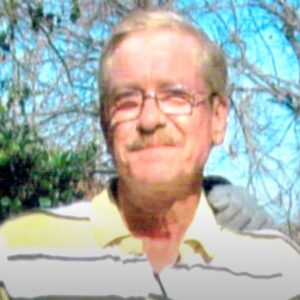
Bruce Harkey in his 60s
And then there was Bruce Harkey. I went through archives of newspapers and genealogy sites to build Harkey’s background for myself rather than piggyback on the Texas Monthly article and Dateline episode (both of which were amazing, by the way). Since I don’t have limited space, I was able to pick up a few more details.
Bruce was in Nevada for most of the 1970s where he worked for at least four years as a policeman between 1978 and 1982. In the mid-1980s, Bruce sold real estate for a couple of years in Austin, but that gets old, and he goes back to Reno and takes on a sales job there. Before long, he hops over to California, then back to Austin in 1994 where he is living in Seguin and running Valley View Healthcare. That appears to be his first nursing home administrator job. And then he’s all over Texas working in nursing homes … Seminole, Austin, Pflugerville, Marble Falls, and Waco.
I read in the Texas Monthly article he worked for the Texas Attorney General’s office as an investigator of Medicare fraud and nursing home abuse, but I couldn’t put my finger on which year, or years, he worked there. Bruce was a nice-looking man with sandy hair and he was a talker. The ability to talk to anyone might have made him popular with the ladies. So popular that he married eight times.
Their names were Judy, Elisa, Michelle, Jennifer, Rene, A’Lann, Susan, and wife #8 was “Kami.” They married in 1996 when he was 44 and she was 20, and in 1998, they had a little girl together.
During their marriage, Bruce and Kami visited Bonnie and Riley quite a bit. I don’t have a definite place of employment for him in 1996, and that may be why he tried to get his father to let him work with him on the farm, but Riley wanted to run it by himself with Bonnie. That enraged Bruce. Kami later recalled, “He would say stuff like, ‘Well, they just need to die so that I can have the farm.’”
After their daughter was born in 1998, Bruce began physically and mentally abusing Kami. Finally, she separated from Bruce. In July 2003, Bruce went to her place of work and told her, “If you mess me around in this divorce, I will kill you.”
He seriously wanted her dead.
On December 13, 2003, The Austin American-Statesman’s front page ran this article, “A Rifle, a Silencer, a Mower; Man Faces Charges for Threatening his 8th Wife.” (Download from this website.) It details how Bruce’s own divorce lawyer in Bryan called the Texas Rangers on his client. Bruce was soliciting Kami’s murder and his friend, not knowing what else to do, went to Bruce’s lawyer. I really want to tell that story too, but I’m going to leave it there and let you follow up, or we will never get back to the day or Bonnie’s death.
Bruce spent about five years in prison for those crimes, getting out in 2008. He had been out of prison for a couple of years when Bonnie and Karen Johnson were murdered. When Bruce had been paroled from prison, he had even begged Bonnie to let him move in with her because his Austin half-way house would not let him leave without an address to go to.
An ex-wife, Jennifer, moved in with him at Bonnie’s. They took over the top floor of her home, and Jennifer said that Bonnie was as sweet as she could be to them both. Bruce and Jennifer moved out, eventually, and into 907 W. Commerce St. in San Saba. On a hunch, I looked up that address in the county records and it had belonged to Bruce’s late grandparents, Riley’s parents. But Bruce could not even be happy having that home. He was just a very greedy man who wanted everything his parents had worked for.
When Bruce and Jennifer moved out, Bonnie was beginning to suffer from dementia. Connie became her guardian and had her driver’s license revoked. Her behavior had shown she was too confused to drive herself places.
Connie was in charge of the orchards for a while. She was as entitled to run them as the boys. Several years before Riley Harker died of bone cancer (probably brought on by the use of strong chemicals on the farm), he had bought “the Prichard Orchard” which was right at 95 acres and a lucrative property; he would leave it to her in his will. That made the entire Harkey business holdings of 300 acres of pecan trees on the San Saba River. Riley’s will instructed that if he died first, Bonnie had a life estate in his assets. After she passed, Connie would get the Prichard Orchard, and John and Riley would each get an orchard and split the rest of the estate.
In 2009, John and Bruce tried to remove Connie as Bonnie’s guardian and get control of the farm. The court said, “No.”
Bonnie’s daughter died suddenly in 2011 of pneumonia, and Connie’s death left Bonnie and the orchards unprotected.
Again, John and Bruce wanted to get some kind of control over the estate; they wanted Carl Pressley to be her guardian, a ridiculous suggestion. Bonnie told the judge she was afraid of all the “boys” and the judge wisely appointed Darrel Spinks, a San Saba attorney, to take the correct legal actions to secure Bonnie’s welfare and her estate. Darrel Spinks became legal guardian of the estate, which was the property, business, and orchards. One of Betty’s friends, Betty Ann, was court-appointed to become guardian of her person. Betty Ann stopped by the house regularly and hired caregivers who could be with Bonnie around the clock.
Betty Ann told Dateline that Bruce wanted her to put Bonnie in a nursing home, but Betty Ann wasn’t about to keep Bonnie in a nursing home as long as she could have caregivers come to the house.
With Connie gone from the picture, apparently without a will, Carl Pressley inherited the Prichard Orchard, a piece of property worth at least $540,000 in 2011, but he couldn’t touch it as long as Bonnie was alive … strangely, however, there’s not much in my sources to say Carl was very concerned about it.
Carl had demanded a thousand or ten thousand, here and there from Bonnie, but Bruce thought in terms of getting his hands on a million dollars; and like Carl, neither Bruce nor John could touch the assets as long as Bonnie was alive. Unfortunately, Riley didn’t think about how Bonnie’s life had to end before his greedy sons could get their money. It never crossed his mind that Bruce was as heartless as he turned out to be.
Unfortunately, Riley didn’t think about how Bonnie’s life had to end before his greedy sons could get their money. It never crossed his mind that Bruce was as heartless as he turned out to be.
Good old Uncle Bruce, who had cozied up to Carl by this time, offered him $75,000 for the future rights to his property. Carl agreed to sell the Prichard Orchard to him and John for $75,000; and he agreed to take $7,500 in a down payment, but Bruce was broke, so Carl received nothing right away.
There was more property than just the orchard property in Riley’s estate, and Darrel Spinks made a deal to sell a $95,000 wheat field out of the estate’s holdings to a neighbor. From what I can tell, Bruce got around $30,000, and he and John paid Carl the $7,500.
Now … here’s what happened next … there was a buyer for the Prichard Orchard, the property formerly belonging to Carl.
Enter Texas Ranger, Captain Woodrow Call from Lonesome Dove, Texas
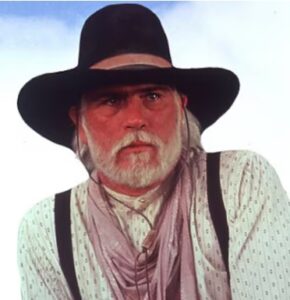
Capt. Woodrow Call played by Tommy Lee Jones
And by that I mean Tommy Lee Jones, one of my favorite actors in my very favorite western series EVER. Rumor had it that Jones had been eyeing the Prichard Orchard because of the excellent water rights with it.
John and Bruce reached out and made a deal to sell it to Jones, whose property abutted theirs. He agreed to $574,000 and some change, but the terms for Bonnie Harkey were dismal; she would get only $44,000, and Darrel Spinks said “no.” (I promise we are almost back to the day that Isaiah made the 911 call.)
Spinks was doing his job to take care of Bonnie’s estate, and Betty Ann wasn’t putting Bonnie into a nursing home, which made Bruce furious. The lawyer had also leased out the pecan orchards to a longtime pecan farmer named Winston Millican. Bruce called Spinks daily, telling him that Millican didn’t know what he was doing, and Spinks needed to terminate the lease and let Bruce manage the orchards … for a salary, of course.
Spinks would not pay Bruce, whose track record on ethics was horrible. That was another reason Bruce was fit to be tied and his patience non-existent. Finally!! Back to the Evening of March 25, 2012
Around 8:30 that night, Lillian King’s mother heard that Bonnie was missing and that Karen Johnson was dead. That poor lady knew that Lillian and Carl had been to Bonnie’s house.
She called a friend and asked her to call the sheriff’s department and say, “Lillian King and Carl Pressley are in Normangee in a campground, and I’m 99% sure they have Bonnie Harkey.”
The friend called the sheriff’s office and dispatch reached Deputy Sheriff Bill Price, who had returned to the office to man the phones while volunteers continued searching for Bonnie.
Sheriff Allen Brown called Carl on his cell phone. He had to call the number many times before Carl finally answered. Sheriff Brown told Carl that his grandmother was missing and her caretaker, Karen Johnson, was dead.
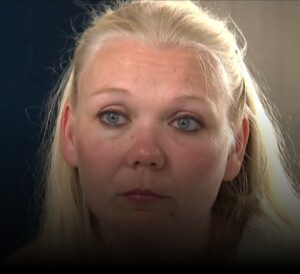
Lillian King (Dateline photo)
“Carl started crying at this point,” Lillian King would say later. “But they weren’t real tears.”
The Sheriff told Carl that he and Lillian had to come to the sheriff’s office immediately, a drive which would take them most of the night.
Back at the sheriff’s department, Carl and Lillian were questioned separately.
Lillian sang like a bird, but it took Carl two more hours. He was blubbering when he finally confessed to what they had done. Here are the awful things that Carl and Lillian did that day…
Carl sneaked into the house, climbing through a window, while Bonnie was at church. The plan was to wait until she went to her bedroom and laid down for her nap; Carl would sneak in and smother her while she was asleep.
Bonnie’s grandson hid in a room downstairs, and as he waited, he smoked his meth pipe, which was of no help to the ultimate execution of his plan. He was jumpy, and his mind played tricks on him.
Once Isaiah, Karen, and Bonnie had returned, Carl apparently forgot to wait until Bonnie was taking her nap because he texted Lillian to come to the house and ring the doorbell to distract Karen. When Karen answered the door to let Lillian come in, Carl panicked because Karen saw him.
Lillian saw Carl jump Karen from the back and she visited with Bonnie in the living room to keep her distracted, and Carl had tackled Karen with a bear hug, threw her to the floor and smothered her by laying on her with his full body weight which was probably about 200 pounds in March 2012.
When she was dead, he went into the living room with his grandmother and told her to please come to her bedroom. He wanted her to pray with him; she agreed, and they left Lillian with Karen’s lifeless body sprawled out on the other side of the door.
When they were in Bonnie’s bedroom, Carl, all five feet and seven inches of him, lunged toward her with a pillow, but as that happened, Carl thought he heard the doorbell ringing and stopped quickly. Bonnie began to call out to Lillian, saying that Carl was trying to kill her. Carl calmed her down and convinced her she was mistaken—he just wanted her to go for a ride with him.
Lillian drove Carl’s car about 200 miles to the campground where they were staying in Leon County because Carl’s license was revoked. There, Carl and Lillian were camped in an RV loaned to him by a friend he knew through his motorcycle club. About this time, Isaiah was probably calling 911.
Carl convinced Bonnie he wanted to show her “a good fishing hole” he had found, and Bonnie, undoubtedly happy just to be with Carl, went with him. They walked to a nearby ravine and down the embankment to a small stream where Carl hit Bonnie in the back of the head with a tree branch; he then pushed her into the water and held her there until she stopped struggling.
Carl covered his grandmother’s body with mud and leaves and left her there.
All I can think about is how creepy it was for Isaiah to learn that a cold-blooded killer had been in that house that afternoon. if Isaiah had come out of the room where he was playing video games, Carl would have almost certainly killed Isaiah. He might have done so if he had just known he was in the house. If Isaiah had not been there to make a 911 call that afternoon, Carl and Lillian could have put a lot more time and distance between themselves and the discovery that Karen was dead and Bonnie had disappeared.
Uncle Bruce Comments on Carl’s Arrest
I’m going to move forward a day and then go back to Carl’s confession, because there is more to come. On March 27, the following Tuesday, ABC 13 broadcasted this about Carl Pressley and his arrest.
“Court records indicate Pressley had worked as a machine operator on his family’s pecan farm.
[Bonnie] Harkey’s stepson, Bruce Harkey, told The Associated Press that Pressley was adopted by the woman’s daughter. He said Bonnie Harkey took Pressley in as a teenager and supported him with ‘hundreds of thousands of dollars’ in spending as an adult for purchases, including a truck, dozens of new tires and legal expenses.
In 2006, Pressley was convicted of misdemeanor assault for allegedly choking his estranged wife—not King. He was sentenced to probation.
His legal troubles mounted: He served multiple jail stints during the last several years for harassment of his uncle, driving with an invalid license and violating probation when he allegedly threatened his mother.
Through it all, his grandmother continued to support him, Bruce Harkey said.
‘Carl ran through money like water,’ he said. ‘She’s the only woman who ever nurtured, ever cared for him, provided for him, gave him everything in the world that he wanted.’”
That sound bite from Bruce was too good not to share.
Now, Let’s Go Back to Carl’s Confession that Night …
By the time Carl was to this point in his confession, it was actually early morning on March 26.
When the investigators asked him if anyone else was involved, he said his girlfriend, Lillian, was.
“Who else?” they asked.
“Bruce. He said he would put money in my bank account if I would do it,” and Carl began to tell them about a crazy deal he struck with Bruce Harkey … but knowing this was Carl and Bruce bargaining over killing Carl’s grandmother, investigators believed just about every word of it.
According to Carl, Bruce had come to see him on Friday, March 23, to propose a deal.
“Get rid of Bonnie this weekend,” Carl claimed Bruce said.
“I’ll pay you. I’m gonna be out of town. I don’t want nothin’ to do with it. Don’t tell anybody I had anything to do with it.”
Carl swore Bruce gave him $100 and promised to deposit $150 more in his bank account on Monday once Bonnie was dead.
Plus, Bruce reminded Carl that once this happened, he would receive a payout from the estate, the balance of $67,500 owed to him by Bruce and Carl for his interest in the Prichard Orchard.
Carl also said Bruce had offered $500, but Carl said he would do it for $200 since he knew Bruce was having financial problems. As Deputy Price would remark later, “Carl has not been accused of being very intelligent.”
Carl told Bill Price that Bruce had been talking incessantly about getting rid of Bonnie. Bruce claimed, “Bonnie killed my son. She needs to suffer the way my son did.”
Bruce said they were running out of money. He had taken in two of Jennifer’s granddaughters, and his money from the wheat field sale was going rapidly.
“They ate out all the time, and they got into online gaming,” explained Sergeant John Wilkerson, who obtained Bruce’s bank records during his investigation.
“They were blowing through that money.”
With about $20,000 left, and almost no other income to speak of, Bruce had grown nervous. In his confession, which was recorded by the dashcam of a patrol car, Carl said Bruce had approached another potential hit man about killing Bonnie and her lawyer, Darrel Spinks, but that person wanted $10,000. Bruch found the asking price too steep. That’s when he’d settled on Carl.
After unloading his guilt on Price and Wilkerson, Carl was inconsolable and wailing that Bonnie wouldn’t forgive him for what he did. Wilkerson said, “I told him that Mrs. Harkey had forgiven him for everything else he had done.”
Hours later, Bruce heard Carl had confessed and that the investigation was tightening around him, and typical of Bruce, he began to bluster. He even called Sheriff Brown.
“Allen, I just got a phone call from my wife saying that she just got a phone call about you coming to arrest me, my brother, and her.”
Bruce was indeed arrested two days later, for criminal solicitation of capital murder, an allegation he called “absolutely and totally ludicrous.” He protested to anyone within earshot.
“First of all,” Bruce told a deputy, “I wouldn’t hire Forrest Gump to commit murder, you know what I’m saying?”
“Second of all, if I thought somebody needed killing that bad, I would take care of it myself.”
But Bruce had also run his mouth about his disgust with Bonnie all over town, even to a justice of the peace, saying that he “just wished that old bitch was dead.” And, boy! His later protestations about having nothing to do with Bonnie’s murder fell on deaf ears.
Ol’ Bruce had police experience in Reno and had learned it was important to have an alibi.
Links to Photos
- Bonnie & Riley’s Blended Family
- Lots of Pictures of the Family
- Karen Johnson’s Picture and Isaiah in the background.
- Miscellaneous
He was so crafty that he went around town before he left to go see his brother, John Harkey, in Fort Worth on March 23, telling everyone where he was going. Bruce wanted to be sure and set up his alibi before he needed it.
Jennifer was never arrested, and Bruce’s brother, John, suffered a fatal heart attack three months after Bonnie’s murder. My research didn’t turn up anything about John or Jennifer taking part in the murders of Karen Gail Johnson and Bonnie Harkey.
While awaiting trial, Carl, Lillian, and Bruce were held in different jails.
In exchange for lighter sentences, Carl and Lillian agreed to testify against Bruce, and jurors also heard from two inmates who claimed that Bruce wanted to hire them to kill both Carl and Spinks; Bruce tried to hire them while he was sitting in jail. The jury took one hour to find him guilty and Bruce was shocked that he was convicted, much less sentenced to life without parole.
Carl received life without parole, too. I suppose if Carl had not testified against Bruce, he would have faced a trial to determine his punishment and may have received the death penalty.
Lillian received a sentence for 45 years in prison, too. A bad life for Lillian was set in stone when she partnered with Carl Pressley; she had chosen a life as rotten as the fruit of a pecan tree with a case of shuckworms. Both Lillian and her mother were safer without Carl Pressley’s daily presence in their lives.

Pecans with Shuck Worms
ABC 13 Houston reported that a friend of Carl’s had been trying to reach him on the evening of March 25, 2012. Carl tried to call him back and left a message. “Man, I’m not trying to avoid you, but my grandmother passed away. I’ll talk to you later.”
If you have enjoyed this blog post and video, please FOLLOW my Facebook page and subscribe to my brand new YouTube channel which has all of SIX subs at this time. [Smiling over here, but don’t have an emoji!]
SOURCES
Rap sheets for Carl, Lillian, and Bruce are downloadable from this page.
NBC, Dateline, Season 23, Episode 43, Queen of the County; Peacocktv.com
Sonia Smith, “A Tree is Known by Its Fruit,” Texas Monthly, Austin, Texas, December 9, 2014; http://crimesy.com/txmoharkey.
Unnamed Author. 3-27-2012, ABC13 Houston, Online, 1; “Caretaker, elderly woman slain in Central Texas”; Pg. https://abc13.com/archive/8596807/, 4-27-2025; Date Collected: Describes all Carl’s legal troubles.
Steven Kreytak, “A Rifle, a Silencer, a Mower; Man Faces Charges for Threatening his 8th Wife.”, The Austin American-Statesman, Austin, Texas; 12-13-2003; Pg. 1, 17, https://www.newspapers.com/image/356978998/ ; Date Collected: 5-2-2025.
Second body found in San Saba murders; sheriff says two in custody, Brownwood Bulletin (TX), March 27, 2012; from Newslibrary.com; Record Number: 1efbc3d4c0d6c6c394bb7458d251c032eebaf/
Third Arrest in San Saba County Double Murder, Brownwood Bulletin (TX), ,Brownwood Bulletin (TX), March 28, 2012; from Newslibrary.com; Record Number: ◦6b122cc94c33f4a0268aa7b2d7fe21787d7588bf7
Records from Ancestry.com.
SUPPLEMENTAL: Tracking Bruce Harkey
